Northwest Side parish adopts name of first millennial saint
By Kevin Beese Staff Writer — July 20, 2025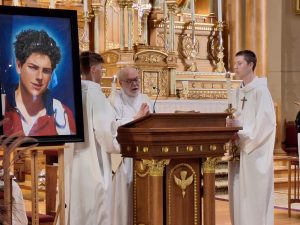
Deacon Kevin Kucik reads the gospel next to a picture of Carlo Acutis, an Italian teen who used technology to evangelize and is scheduled to become a saint of the Catholic Church in September, during a Mass on Tuesday at St. Hedwig Church in Chicago. St. Hedwig is part of Blessed Carlo Acutis Parish, the only parish in North America named for the soon-to-be saint. (Kevin Beese/Chronicle Media photos)
While “The Saint Who Wore Sneakers” sounds like a summer Disney movie, it is a scenario being celebrated at a Northwest Side parish.
Blessed Carlo Acutis Parish in Chicago’s Logan Square neighborhood is the only parish in North America named for the Italian teen who used technology to evangelize and who died of leukemia in 2006 at the age of 15. Acutis is scheduled to be elevated from “blessed” to “saint” on Sept. 7.
Rev. Ed Howe, overseer of the Chicago parish which includes two churches and a school, said that Acutis made a difference documenting miracles.
“Pope Francis pointed out in 2018 that we think of saints as world figures: Mother Teresa, Pope John Paul II, but that most saints made a difference in small towns,” Howe said. “Even Francis was really just known in the Assisi community. He became a world figure later.
“Carlo Acutis was in Milan. He played soccer and taught catechism. He worked on websites. As a 12-year-old, he started documenting miracles and taught himself coding.
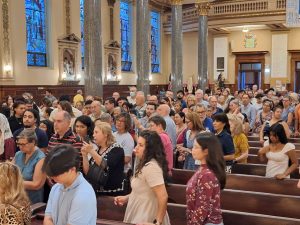
People line up for veneration of a relic from Blessed Carlo Acutis.
“He was a pioneer of modern-day evangelizing, but at the time when he died no one knew him except the people of northern Milan. Pope Francis called him ‘the saint next door.’ He made a difference. He stood out.”
Howe pointed out that there is no building named for Carlo Acutis, that the name is for the parish covering St. Hedwig Church and St. John Berchmans Church and School.
Archbishop Domenico Sorrentino of Assisi, Italy and curator of the tomb and relics of Blessed Carlo Acutis, celebrated Mass on July 15 at St. Hedwig Church, offering a reflection on the life and legacy of Acutis.
Sorrentino said Acutis’ elevation to sainthood should signal a rebirth for Catholics in not just Chicago, but around the world.
“We are all bothers and sisters,” Sorrentino said. “We must know and feel that those around us are truly our brothers and sisters. We have one father.”
Boost in faith
Howe said naming the Northwest Side parish in honor of the Italian teen has been a shot of adrenaline.
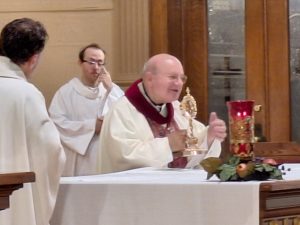
Sorrentino talks about the importance of the relic of Carlo Acutis (on stand in front of him).
“In all types of religion, when it is the same old thing people lose their sense of deeper meaning. They go through the motions,” Howe said. “As Archbishop Sorrentino said, the attention on Carlo Acutis is another opportunity for renewal.”
Howe noted that at the end of COVID-19 in 2022, combining churches was necessary in the Northwest Side neighborhood.
“We needed to merge churches. We needed to survive,” Howe said. “Both St. Hedwig and St. John Berchmans had both declined in numbers.”
With the merger, the question was what to name the new parish.
“Some people said, ‘St. John Berchmans-St. Hedwig Parish,’ but that was wordy,” Howe said. “It was brought up that Carlo Acutis was becoming ‘blessed’ and was in the process of being a saint.
“The thought was that he was a young person and maybe he would be inspiring to young people, so we went with Blessed Carlo Acutis Parish.”
Howe said the documentation that Acutis did on Eucharistic miracles has been used all over the world, including documentaries about the miracles.
“He was an ordinary teen in many ways,” Howe said, “but today he is bigger than when he was alive. There is spirituality that grows. There is a sense of renewal.
“People look at a millennial kid and ask ‘Why canonize him?’ He would be there for people. He would influence and inspire people and that continues today. You can look at Carlo and he looks like a friend. “He played soccer and video games. He might be the only saint to have an email address.
“Other saints were of different times. Carlo was buried in sneakers and a jogging suit.”
Paying tribute
Longtime St. Hedwig Church member Evelyn Rodriguez was one of the more than 500 people on hand for Tuesday’s Mass and veneration of the encased, but not visible, relic of Carlo Acutis – his pericardium (the sack that protected his heart).
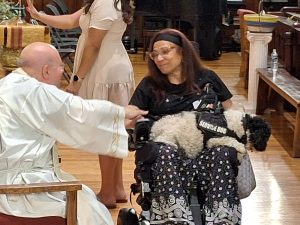
Archbishop Domenico Sorrentino of Assisi, Italy, curator of the tomb and relics of Blessed Carlo Acutis, greets Evelyn Rodriguez, a member of St. Hedwig Church and Blessed Carlo Acutis Parish, during the veneration of a relic from Acutis.
“I’m glad I came,” Rodriguez said about attending the Mass and veneration. “When I heard about it, I’m like, ‘I’m here. I’m here. Nothing’s going to stop me.’”
Hers was one of the first Latino families to join St. Hedwig Church in the early 1970s.
Surviving a car accident and a battle with cancer, Rodriguez said she knows the inner workings of the Northwest Side church.
“I know how this church looks from behind everything,” she said. “I know this church like the back of my hand.”
Father Howe said the initial move to “Carlo Acutis” for the name of the parish was polarizing.
“Some people were upset by the merger. Some felt the community has to change,” Howe said. “The parish became ‘Carlo Acutis’ after the merger.
“It has become a point of unity. We have united through ‘Carlo Acutis.’ It has become a point of community. People have rallied behind a person who is a modern-day example of Christianity.”
Veneration
Howe said after the July 15 Mass, people waited for more than an hour for the chance to get close to the relic of Carlo Acutis.
“There was veneration and prayers,” Howe said. “People came with pictures in hand of loved ones who had died and family members who were sick or having trouble.
“They asked, ‘May our prayers be answered.’ They mentioned different things when they came up to the relic.”
Howe said he has visited Assisi and all around the crypt of St. Francis, there are pictures of loved ones that people have brought.
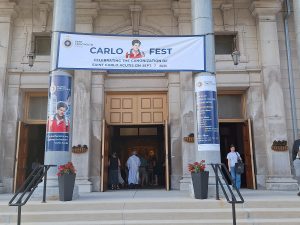
A banner in front of St. Hedwig Church in Chicago’s Logan Square neighborhood welcomes visitors to Carlo Fest, a celebration for the canonization of Carlo Acutis.
“It’s somewhat common at the veneration of a relic. People are asking for Carlo’s help through intersession,” the priest said. “In part, it comes from the old patron-client system, like today’s aldermen.
“People went to the patron, not praying directly to God, but going through an intercessor. Today, there is more praying directly to God, but for many centuries people would feel they were not worthy to pray directly to God.”
He said a relic brings the saint’s physical presence to people.
“It’s like at a funeral when you honor the loved one by bringing something of theirs,” Howe said. “You connect through their remains.”
The priest said veneration is normally done after Mass so as not to take focus away from the Eucharist.
“Veneration can confuse people,” Howe said. “Having veneration during Mass, they can focus on the relic and not on the Eucharist.”







